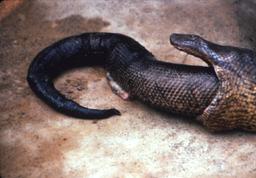The following copyrighted material is intended for individual use of the researcher, and may not be copied or distributed without written permission from the copyright holder. You may use it for non-profit scholarly purposes. The reference: Rivas, J. A. and R. Y Owens. 2000. Eunectes murinus (Green anaconda): cannibalism. Herpetological Review 31: (In press)
Eunectes murinus (Green anaconda): Cannibalism (click here for a pdf version)
One instance of cannibalism in the green
anaconda (Eunectes murinus) has been reported in the literature
(O’Shea, M. T. 1994. Herpetol. Rev. 25: 124). This observation involved a
female eating a smaller conspecific of unknown sex. Here we report three other
cases of female anaconda predation on conspecifics. These observations occurred
during the breeding (dry) season in the Venezuelan llanos, Distrito Muñoz,
The first observation involved a large female
(434.7 cm total length (TL) and 40 kg) that was caught in 27 April 1995 next to
a breeding aggregation (Rivas 1999. Life history of the green anacondas with
emphasis on its reproductive biology. Ph.D. dissertation at the
All the records of cannibalism in green anaconda involve cannibalistic females, and both times the sex of the cannibalized individual has been known it has been male. This asymmetry is probably a consequence of the strong sexual size dimorphism found in the species; where females are much larger than males (Rivas op. cit.). Green anacondas become concentrated around the more permanent water sources during the dry season, and at this time breeding occurs (Rivas op. cit.). Male anacondas looking for water and/or females appear to be especially vulnerable to cannibalism by females. After mating, pregnant females do not eat for seven months (Rivas op cit.). It is possible that breeding females eat their mating partners in order to help them survive the long fast associated with pregnancy
Acknowledgement: We thank the Wildlife Conservation Society and the National Geographic Society for funding this research. COVEGAN allowed us to work on their land. We also thank G. M. Burghardt for editorial comments on the manuscript
Jesús A. Rivas. Graduate program in Ethology, Dept. of Ecology &
Evolutionary Biology,
Current address for correspondence :
Figure 1 Females anaconda regurgitating a male (notice the hemipenis in the shot) Photo Tony Rattin
